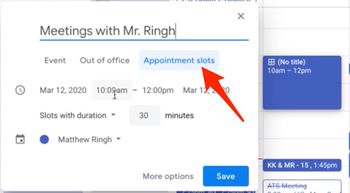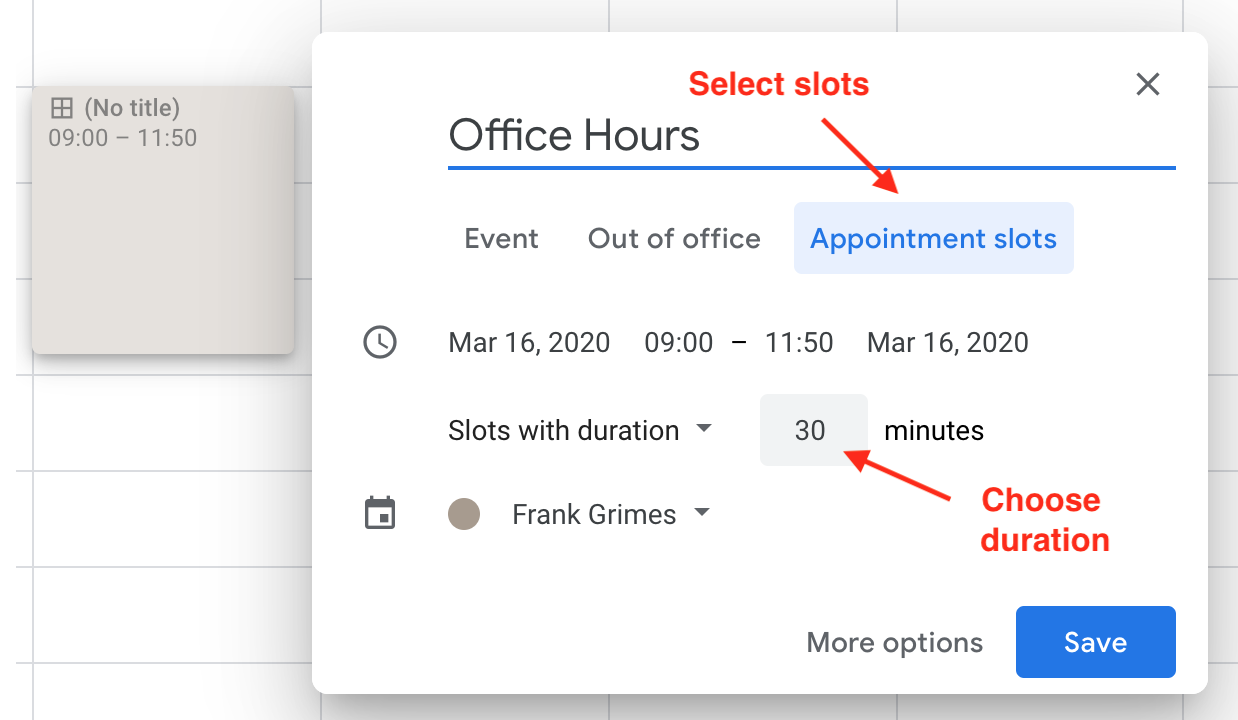Appointment Slots Google Calendar 2020
Appointment Slots is a feature of Google Calendar that allows you to allocate blocks of time for appointments – and for others to reserve appointments of fixed lengths during those times. You might find Appointment Slots helpful when you need to schedule multiple fixed-length meetings or presentations with different individuals or groups. Below are some examples of scenarios in which Appointment Slots could prove useful.

How
You can create an appointment slot when you access your Google Calendar with your BU Google Apps account from calendar.google.com. For detailed guides on creation and distribution of appointment slots, please reference the following Google guides. (Note: You must be logged in to BU Google Apps to access these instructions.)
Note that you have a number of options for distributing your appointment slot once it has been created:

Creating appointment slots. Open your Google Calendar. Click in a time slot, or click and drag to select multiple hours. The new event box will open. Click the Appointment slots link. Click More options. Enter the details of the appointment slots.

- If you are a professor, you can use Blackboard Learn to distribute the appointment registration link to your class
- You can distribute the link manually to a group of contacts, a series of email addresses, or a mailing group
- You can invite individual email addresses on the appointment slot page
- You can invite an entire Google Group using the group’s email address. For more information, see this article
You must set up the actual appointment slots before others can book them. Go to Google Calendar. Click the appointment slot event on the calendar, then click on “Go to appointment page for this calendar”. Copy the calendar’s appointment page link found at the top of the page. Email this link to people looking to book an appointment. Google Calendar Appointment Slots 2020, no download blackjack, casino grade poker chip weigh, gambling casino near me $5,000 Relatively young European bookmaker – 22BET – is established in 2017.
Why
- If an individual schedules an appointment using his or her BU email address, it will appear on his or her Google Calendar. It is not necessary to have a BU email address or even a Google account to make an appointment, however.
- Likewise, the appointments will show up on your own Google Calendar, and you will be able to take advantage of other features such as setting alerts
- You can invite guests to the appointments, such as a teaching assistant or another e-board member
- Every BU student, faculty, and staff member has a Google Apps account or the ability to create one
Potential Uses for Professors, Faculty, and Staff
- Schedule appointments with advisees during the weeks leading up to registration
- Schedule group or individual presentation times for a class final project
- Schedule one-on-one meetings with lab assistants, teaching fellows, etc.
- Schedule interviews with candidates for a particular position
Potential Uses For Students
- Schedule presentation times for a club or organization and its members or subgroups
- Schedule times for club members to work a particular event
- Schedule sessions for club groups to meet with a particular guest, E-board member, etc.
Set up appointment slots for others to register for as a Google Calendar Event. This is not the only approach.
Step-by-step guide to Create Appointments
To List Your Appointments
To Use Zoom With Appointment Slots
Step-by-step guide
- Log into your Google account in a browser and go to your Google Calendar. Click a date to set up appointments for, or click the +Create button in the top left corner.
- Select Appointment Slots just below the Title field.
- Add a Title, such as the topic or purpose of the meetings, e.g., Interviews, Reviews, Office Hours.
- Set the date and time range for all the appointments in a block. Unless your appointments are around the clock, a block of appointments will start and end the same day: be sure to set the second date the same as the first (depending on the calendar view you were on, they may default to a day apart).
- Set the Duration for each individual appointment. Include the time you need between appointments in the total duration. For example, for 15-minute meetings with 5 minutes in between appointments, set the duration for 20 minutes.
TIP: You cannot delete an appointment slot, so if you want a break that is the length of an appointment, book the appointment for yourself and change the Title to something like Free Time. If the break isn’t equal to a multiple of the appointment duration, you’ll need to set up separate blocks of appointments. - Set the calendar you want the appointments to be on (for yourself, does not apply to those making the appointments). See TIP below.
- Click Save or More Options to :
- Set up repeating appointments. If you want the same block of time across more than one day, or every week, for example, click the Does not repeat dropdown and select Custom…
Enter the settings for repeating this block of appointments, then click Done. - Specify the Location where the meeting will occur, your office, for example. If this will be a Zoom meeting, see the instructions below.
- Enter a Description: here is where you enter the URL for your Zoom Personal Meeting ID. Users making the appointment can edit the Description field for their slot, so you can request information from them by instructing them to add text to this field.
- Add Guests to collaborate on managing the appointments. This is not for those you’re inviting to make an appointment, but rather someone you want to be able to see the appointments that have been made. For example, an assistant can set up these Appointment Slots and make the Supervisor who is actually conducting the meetings the Guest, or vice versa.
- Copy the link that you will send or post for users to make appointments by right-clicking the link for This calendar’s appointment page, or click to go to the Appointment page and copy the URL from the browser address bar.
- Click Save when you’re done.
- Set up repeating appointments. If you want the same block of time across more than one day, or every week, for example, click the Does not repeat dropdown and select Custom…
- If you don’t set More Options or you have closed that screen, you can get the Appointment Page link from the event on your Google Calendar: click the event for the Appointment Slots block (it has a grid icon before the title), then right-click the Go to appointment page for this calendar and Copy link address; or click the link, then copy the URL from the browser address bar.
NOTE: All Appointment Slots created for a calendar are visible for anyone with a link to the Appointment Page, so if you set up more than one Appointment Slots type, be sure the Titles are distinguishable. - Users with the link to the Appointment Page can click the button for the time slot they want to select. Time slots already selected are no longer visible. To see the details of the Time slot, move the mouse pointer over it. Click Save to make an appointment for the selected time slot.
- If users want to cancel their appointment or change to another slot, they should delete the event on their calendar, then go back to the Appointment Page and select another slot. The previously booked slot will be open for someone else.
To Print or create a PDF of your scheduled Appointments you will filter down to the data you want to see in the list: first which calendar (if you have multiple), then which day(s).
- If you have multiple calendars, display only the one that you made the Appointment Slots for. If you have several calendars and the ones you have visible are not easily selected, first duplicate the browser tab for your calendar (right-click the tab > Duplicate), then you can uncheck the calendars you want to hide. The calendars selected on the original tab will remain selected.
- Change the View dropdown (upper right) to Schedule.
- To show just the slots for a set of Appointments, use the Search field and enter the Title. Google does not provide a way to Print this filtered list as described in the following steps, but you can select and copy the text (use Ctrl + C, because Copy is not in the right-click menu) to paste elsewhere to edit and print.
- Click the Settings gear (upper right) > Print. Specify the date range and other options, then click Print.
- The Print Preview is displayed with settings to specify the Destination (Save as PDF, printer, etc.). Click the Save/Print button. When you’re done, close the duplicate tab with the single calendar to return to the view with all your other calendars.

TIP
If you plan to use Appointment Slots regularly and often need to print a daily list, consider creating a Calendar just for your appointments, then you can easily filter out all other events with step 1.
Google Appointment Slots
You can include a link to your Zoom account for conducting meetings for the Appointment Slots you set up. If you want the meetings to be private, that is you’re meeting with one person at a time and do not want others to join a meeting before you are ready for them, turn on the Waiting Room option.
- From the Zoom application window, click the New Meeting dropdown, then click your Personal Meeting ID (PMI) > PMI Settings. Check the box for Enable Waiting Room, then click Save.
NOTE: Turning this on means you will need to Admit anyone using your PMI until you turn the option off. See Zoom documentation: Using Your PMI - Get your PMI URL: Click on your headshot in the top right corner of the Zoom application window > My Profile (this will open in your browser). The URL is in the Personal Meeting ID section of your Profile screen: if the Show link is visible, click it to display the actual URL. Copy this URL and paste it into the Description field for your Appointment Slots event, step 7.c above. You might be inclined to enter the URL in the Location field, but the onscreen displays of the Appointments will also display the URL over and over; just enter Zoom for the Location with the URL in the Description field.
- Before your first Appointment, log into the Zoom application. When users click the URL to attend the appointment, Zoom will display a notification to wait for you to start the meeting. You will see in the Participants panel of the Zoom application window (click Participants to display it on the right) that the user is in the Waiting Room.
- Move your mouse over the name and then click the Admit button. The name will move from “is waiting” to “in the meeting.”
- To move someone out of the meeting before letting the next person in, the person can leave the meeting, or you can move your mouse over the person’s name and click the More > menu and either Put in Waiting Room (if you want to meet again in this session) or Remove if you have finished meeting.
- To alert users in the Waiting Room of something, you can click the Message link, then use the Chat to text them. The Chat window dropdown lets you message Everyone (in Waiting Room) or Everyone (in Meeting) or a specific person in the meeting.
- If the Chat window covers the Participants list, click the More… menu at the bottom of your Zoom application window, then select Chat to hide it.
Related Articles
